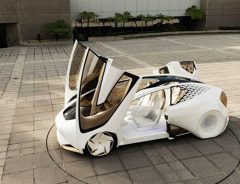- Tags:
- AI / demographics / elderly care / nursing home / Technology / VR
Related Article
-

Universal Studios Japan Gives Way To Final Fantasy Ride, Goods, and Food!
-

Tokyo Reveals AI Technology Yui As Their Futuristic Car For The Year 2030
-

No Sushi, No Life Virtual Reality game – How much sushi can you eat?
-

Yumenographia VR hostess cafe now lets you join without VR gear through “desktop mode”
-

“Pong!Pong!” Adds a Fun, New Dimension to Table Tennis Through Mixed Reality Technology
-

beeat Sushi Burrito Tokyo Serves Delicious Sushi Burritos To Go In A Futuristic Setting



As Yoshihide Suga settles in as the new Prime Minister of Japan, he is faced with some noteworthy issues. Not least of which is the country’s notoriously gray and aging population. As of Setpember 15th, the number of residents aged 65 years or older reached 36.17 million, including Kane Tanaka who recently became Japan’s oldest person ever at the age of 117. That's a record breaking 28.7 percent of the population eligible for retirement and a national pension.
However, Japan’s aging demographics pose substantial challenges in a country with a declining youth population. While political power is concentrated among the older generation, " rel="noopener noreferrer" target="_blank">young voters are tuning out despite attempts to " rel="noopener noreferrer" target="_blank">engage the voting block. This may be worrisome as an ongoing labor shortage and historic national debt seem overwhelming as public spending is likely to be substantially burdened by pension payments.
Nevertheless, in a nation that sells more adult diapers than baby diapers, numerous innovations are needed to ease the burden of caring for the elderly. Ranging from robotics to AI technologies, Japan's industries are prepared to capitalize on the remarkable demographic shift already underway. Their high-tech breakthroughs aim to make life easier for the elderly while assisting caregivers in their work.
AI wheelchairs
Just as in other areas of life in the 21st century, artificial intelligence is being leveraged to provide a greater quality of life for the elderly. For example, Panasonic Corporation is working to integrate the technology into mobility solutions as part of a MaaS—mobility as a service—initiative. The wheelchair they have developed incorporates an autonomous tracking capability that guides the device while avoiding obstacles.
The company originally developed the device in coordination with the airline company ANA and tested it at Narita airport. The device aims to help limited mobility individuals and the elderly navigate the particularly large facility. The wheelchairs work in unison in small groups, with a lead robot being controlled by a station attendant. The following chairs track the leader in a column and are capable of automatic braking and maneuvering. A video demonstration is available on YouTube:
VR dementia
We’ve talked a lot about VR technology, whether used for VR tourism or providing a glimpse into the future. However, a new application may help caregivers provide better, more empathetic care to elderly patients.
Silver Wood Corp, which operates apartments for the elderly, has developed a VR headset that is capable of simulating the experience of dementia. The headset provides a five-minute demonstration that immerses the wearer in the lifelike world of a patient with dementia. The experience is meant to educate and inspire more empathetic care for the afflicted.
Tadamichi Shimogawara, the President of Silverwood, told The Japan Times, “We do not want caregivers and patients to be divided, we would like to create a responsible relationship in which both need each other. This is a way that exactly reproduces the world as it is perceived by patients with dementia. We can experience it through Virtual Reality, which then makes us understand the pain and the difficulties of these people.”
Robots
As mentioned, Japan's lopsided demographics imply difficulties as the country attempts to care for its elderly population. Simply put, as labor shortages threaten several industries, there is simply not enough of the workforce to go around.
Fortunately, Japan’s leading robotics industry is stepping in to help cover the shortfall. Consider Shin-Tomi nursing home in Tokyo, for example, where 20 different types of robots help residents with everyday activities. Japanese people largely view robots positively, so residents at the care facility welcome the extra assistance.
Indeed, many models are available to help. The robot Resyone is another entry by Panasonic—a bed that splits apart into a wheelchair to provide seamless mobility.
The automated device folds into a wheelchair, limiting the number of staff needed to manually move a bedridden patient.
On the other hand, there are other mobility assist devices and companion bots like Paro, a responsive robotic baby seal, and Pepper, an automaton capable of basic interactions. Both companion bots are capable of rewarding interactions, while Pepper can lead games and basic exercises to keep patients active.